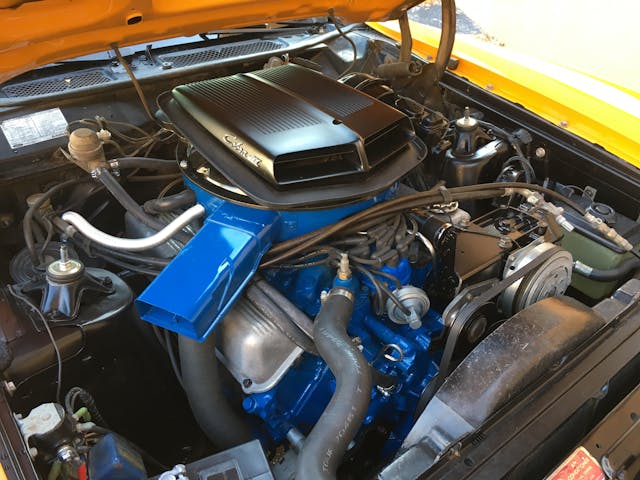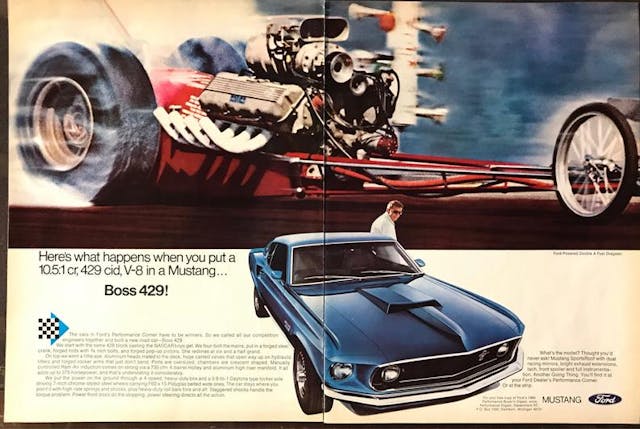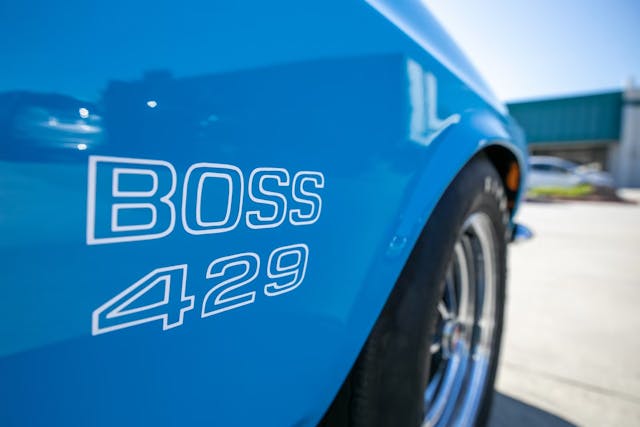Was the 429 Ford’s Peak Muscle-Car Engine?
Coming off our recent celebration of the Mustang, we still have a little bit of Ford on the brain. So, when 4/29 rolled around on the calendar, it was only natural that we thought of Ford’s 429-cubic inch mills. —Ed.
The late ’60s is overflowing with tales of “What if?” For one, what if the post-war momentum in American performance hadn’t been challenged by anything other than the next-fastest car? Well, then the early ’70s came. It was a time when the oil crisis, government regulators, and insurance agencies drowned out the voices of racing teams. Manufacturers didn’t know how to react other than to drop everything and restart. For fans of Ford’s 429-cubic-inch performance V-8, a lot of what-ifs persist surrounding this engine whose flame burned to its full brightness for only a short spell. On this day of April 29 (4/29), we think it deserves some recognition.
For Ford, the 429s it produced from 1968–73 for its next generation of big-block power were visible victims of this rapid change in direction. These engines benefitted significantly from new casting procedures, which helped to drop weight compared to the outgoing Ford-Edsel big-blocks. Since its days as the king of flatheads, the Blue Oval had been studying its cross-town rivals over at GM and Chrysler; Ford began experimenting with advanced overhead cams and other exotic tricks in Indycar, and the new 385 family of big-blocks looked like they would continue the innovative traditions of their forefathers. It was never meant to be, however. Ford would ultimately kill high-performance big-blocks by 1974, leaving the brand’s trucks and full-size sedans—which used the longer-stroke 460 until 1997—as the last bastions of the big-inch legacy.
Cobra Jet:

In 1968, the 429 superseded the 427 as Ford’s premier big-block, replacing the heavier FE-series. This new 385 series, dubbed the Lima, served a wide array of luxury sedan pickups thanks to its brute force at low rpm. These more pedestrian uses for big-blocks were great for the high-performance divisions, too. It gave them an abundant source of big-displacement foundations upon which to build. While most of the big-blocks churned out of Lima, Ohio, were the sorts of things you’d find humming under the hood of a Lincoln Mark III, a select few would slide down another assembly line to be born as Cobra Jets.
With a 4.36-inch bore and shorter 3.59-inch stroke than the 460, the 429-cu-in Cobra Jet promised at least 370 hp thanks to its snappy 11.3:1 compression ratio, and it became the go-to power plant for the late-’60s Fords. You could get a Cobra Jet, with or without a shaker hood scoop, in everything from the Cougar to the Ranchero, and it was the last big-block performance offered in a Ford car as the pressure from insurance agencies and government regulators began to end OEM involvement in motorsports. By 1972, the Cobra Jet had fallen off the ordering sheets as Ford prepared to enter a decade of despair and neutered performance.
The Boss:

If the loss of the Cobra Jet wasn’t tragic enough, the Boss 429 was a truly unfortunate victim of being at the right place at the wrong time. Conceived for production as a justifiable expense of hewing to NASCAR homologation rules, the weapons-grade dominators dropped into the Mustang by Kar Kraft were possibly the peak of the “Win on Sunday, Sell on Monday” mentality among Ford’s racing efforts in the period. Building upon wisdom that was honed through countless laps in the pursuit of speed, Ford threw its engineering might at the 429 to give it one last hoorah in stock car racing, where the big-port Hemis were continually trouncing the field. Unleashed for the Boss was a mammoth big-block with canted valves, hemispherical combustion chambers, and enough port volume swallow an oil tanker. Learning its lesson from the 427 SOHC mishap back in ’66 (when the engine wasn’t properly homologated and became a massive investment loss when NASCAR banned it), Ford met the required production numbers for the almighty Mustang Boss 429’s engine to be eligible into NASCAR competition, selling 859 units in 1969 and 499 in the following year. Notably, two Mercury Cougars were equipped with the Boss 429, sold respectively to “Dyno Don” Nicholson and “Fast Freddie” Schartman for the princely sum of $1.

Due to the placement of canted exhaust valves, which ease the angle at which the exhaust gasses must turn in order to escape the head compared to a traditional wedge design, the Boss’ cylinder head itself was massive. It provided a few packaging challenges, especially in light of Ford’s decision to solicit Kar Kraft to place the wide-shouldered beast between the strut towers of the compact Mustang. Kar Kraft had to modify the Mustang’s strut towers and front suspension to allow for the necessary additional berth. The result, the Mustang Boss 429, was a nose-heavy brute sold to dealers with the claims of a modest 375 hp. The truth? These were barely-detuned NASCAR engines.
With the laser focus Ford was applying to motorsports at the close of the 1960s, we wonder what could’ve happened if the 429 had the privilege of continued development. While it served well with Ford’s Torino and Mercury’s Cyclone in NASCAR, earning some success in the NHRA Super Stock with the Boss 429 Mustangs, the new big-block never experienced the continual development and persistent polish that the venerable FEs did, despite showing exceptional promise. And on that high water mark, we salute the 429.

***
Check out the Hagerty Media homepage so you don’t miss a single story, or better yet, bookmark it. To get our best stories delivered right to your inbox, subscribe to our newsletters.



When the Boss9 got to race, it destroyed the Chrysler Hemi. The 427 SOHC was banned because Bill France was being a jerk about the SOHC being ready to destroy Chrysler & everyone else.
Seriously, the 427 didn`t get banned cause a bloke was mouthing off, it got banned cause it was that good.
Thanks for the information. I have an all original 68 T-Bird 429 Thunder Jet I’m overhauling with the trans this winter. Very nice straight car I picked up and can’t wait for the right goodies to make it the best it can be.
427 had much more impact.
The best Ford was not even a Ford. The Cosworth Indy car V8. It not just won but dominated Indy and F1.
Al yea but …not really. At that point things in Nascar had gotten out of hand. Ford had the 427 SOHC, Chrysler threatened to do a dual over head cam . Ford had the Talladega and Mercury Cyclone Spoiler, Dodge and Plymouth the Daytona and Superbird. which pushed the envelope to the ‘ what the hell is that thing’ point. So they settled their differences well enough to suit both parties. Chrysler had their approved ‘race’ Hemi, Ford the FE tunnel port heads at first then the Boss 9.So to be fair, I think in reality both both sides were happy to not be hucking even more money in a game of mines bigger. As for the 429, great engine worst possible time. The big block era in Nascar ended soon after its release as did the muscle car.
The 427 All day did more for Ford than the 429.
The bans were all political back then. France did not want one brand as he would say stink up the show. He did not favor Chrysler more than Ford or vise a versa.
He pissed them both off and he also played favorites with both.
Smokey Yunick was mad as he ran a Chevy as a independent and as a back door car for Chevy. Because Chevy was not spending as much money they were never given a break.
The 427 dominated, NASCAR, Drag Racing and Road Racing. Shelby would never have been Shelby without the 427 side oiler.
I was at the Don Snyder Collection here in Ohio. If you walk in he has some of the greatest Ford race cars ever. He has some 429 but most all are 427 cars. The Hollman Moody Drag Mustangs. The lightweight Galaxies and a large number of fames 427 Thunderbolts including Butch Leal first Thunderbolt.
The 429 was a good engine but it was used in a more limited capacity for a shorter period of time. It just never did all the 427 did.
Fords racing and Shelby both were built on the 427 from Daytona to Pomona to Le Mans.
Hyper_ You can make a good argument that Shelbys reputation was built on the 427 but was it it? While the 427 Cobra is generally considered the end all and be all when it comes to stuffing a lightweight car with too much motor, it was the small block (289) cars that won the vast majority of races. Add the GT-350 R winning ways in B production, those Trans-Am cars and… I would argue that they made his reputation as a builder. Would Shelby have won the overall at Le Mans without the 427? Hard to say. Those classic 69 Gulf GT-40s were 289 powered don’t forget, although it was a race of attrition. If Ford had stayed with program and gone with Bud Moore built Boss 302s who’s to say .The 429, take a ride in say a 70 CJ Torino , those 385 series really haul the mail and then some. There were just so fewer performance models built that they’ve been largely overlooked by many.
Paul if you want to play the smaller engine game the 5.0 did more than any of the other engines for Ford. It became their SBC as it has so many things you buy to build it and make all sorts of power.
I am a GM guy but the 5.0 in the 80’s and 90’s supported my family. 289 ehhh it had its place but the big wins came from the 427. It touched all parts of the racing world with wins.
As for the if’s leave them on the table. If they did this or that means nothing to history.
For every win in more types of racing and type of car the 427 accomplished much more than any other Ford engine.
One other engine that gets too little attention due to it being early was the Flat head. It was at the Salt Flats. It was in sprints and stock car racing. Even saw road racing and Indy. While it may have not won the big racinges it did more than the 289 and many other engines.
Hot Rodding was built on it as was the performance industry till it yielded to the Small Block Chevy in the market.
Would Shelby have won LeMans with out the 427. Doesn’t matter as his team did win with it.
Hyper- Being a ‘ Ford guy ‘ I couldn’t agree more about the Flattie. If you just say Flathead there’s no need to explain, like saying Vice- Grips instead of locking pliers, though there were countless other side valve engines. Were I to ever do a deuce coupe it would have to have a flathead. Not that aren’t smarter ways to go ( and a Lincoln Zepher V-12 is tempting just to be different ) but I’d understand someone who built an ‘American Graffiti ‘ ” piss yellow ” 5 window with a small block Chevy. I’d bust there balls about it but you know how that is, all in good fun. That being said as a bit of trivia, Fords first V-8 Indy engines were production based Windsors. That was/is the engine in Jimmy Clarks 500 winning Lotus. Largely forgotten because of the out of house Cosworth DFV s later dominance.
ps – for those interested ( and still have ” the books ” ) a picture of the 64-67 Ford Indy engine appears on page 369 Fig Z-5. of ‘Fix Your Ford’ The cylinder heads page 370 Fig. Z-6.
In the old Ford advertisement in the article, the one with the dragster that touts the 429. The dragster is pictured with the 427 Cammer.
I have a1972 mustang it has 302 with 2 barrel carburetor, it looks like the 427 is the way to go.
I have a1972 mustang it has 302 with 2 barrel carburetor, it looks like the 427 is the way to go.